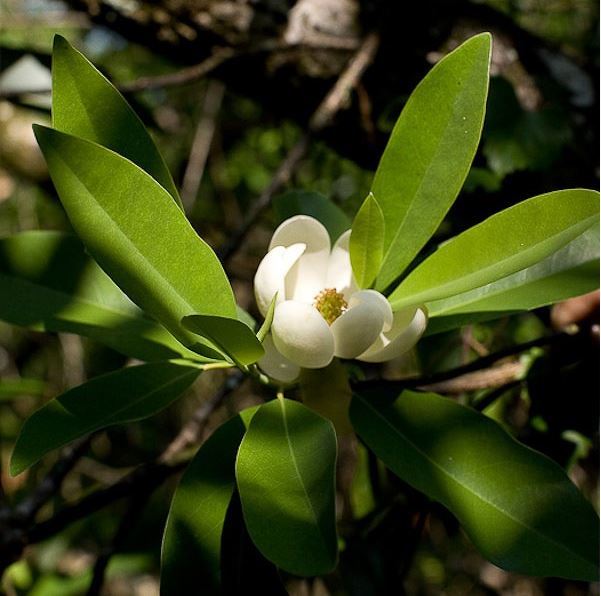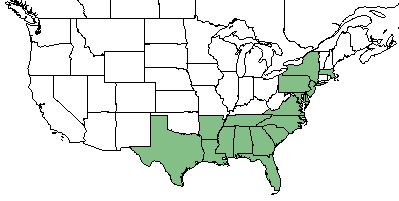Difference between revisions of "Magnolia virginiana"
Juliec4335 (talk | contribs) |
Emmazeitler (talk | contribs) |
||
| Line 1: | Line 1: | ||
{{italic title}} | {{italic title}} | ||
| − | Common name: | + | Common name: Sweetbay<ref name= "USDA Plant Database"/> |
<!-- Get the taxonomy information from the NRCS Plants database --> | <!-- Get the taxonomy information from the NRCS Plants database --> | ||
{{taxobox | {{taxobox | ||
| Line 19: | Line 19: | ||
}} | }} | ||
==Taxonomic Notes== | ==Taxonomic Notes== | ||
| − | Synonyms: | + | Synonyms: none.<ref name="weakley">Weakley, A.S. 2015. Flora of the southern and mid-atlantic states. Working Draft of 21 May 2015. University of North Carolina at Chapel Hill, Chapel Hill, North Carolina.</ref> |
| − | Varieties: | + | Varieties: ''Magnolia virginiana'' Linnaeus ''var. australis''; ''Magnolia virginiana'' Linnaeus ''var. virginiana''.<ref name="weakley">Weakley, A.S. 2015. Flora of the southern and mid-atlantic states. Working Draft of 21 May 2015. University of North Carolina at Chapel Hill, Chapel Hill, North Carolina.</ref> |
==Description== | ==Description== | ||
| Line 28: | Line 28: | ||
==Distribution== | ==Distribution== | ||
| − | ''M. virginiana'' | + | ''M. virginiana var. australis'' ranges from southern North Carolina to southern Florida, then west to Texas. Rarely, it extends into adjacent interior provinces. There are disjunct populations in northwest Cuba. ''Magnolia virginiana var. virginiana'' has a more northern range, growing from southeast Massachusetts south to western North Carolina, southern South Carolina, and eastern Georgia.<ref name="weakley">Weakley, A.S. 2015. Flora of the southern and mid-atlantic states. Working Draft of 21 May 2015. University of North Carolina at Chapel Hill, Chapel Hill, North Carolina.</ref> |
==Ecology== | ==Ecology== | ||
===Habitat=== <!--Natural communities, human disturbed habitats, topography, hydrology, soils, light, fire regime requirements for removal of competition, etc.--> | ===Habitat=== <!--Natural communities, human disturbed habitats, topography, hydrology, soils, light, fire regime requirements for removal of competition, etc.--> | ||
| − | ''M. virginiana'' proliferates in pocosins, bay forests, and swamps in the Coastal Plain, streamhead pocosins, swamps, and sandhill seeps in the Sandhills, bogs and peaty swamps in the Piedmont and Mountains. <ref name= "Weakley 2015"> Weakley, A. S. (2015). Flora of the Southern and Mid-Atlantic States. Chapel Hill, NC, University of North Carolina Herbarium. </ref> Specimens have been collected from shrub tree | + | ''M. virginiana'' proliferates in pocosins, bay forests, and swamps in the Coastal Plain, streamhead pocosins, swamps, and sandhill seeps in the Sandhills, bogs, and peaty swamps in the Piedmont and Mountains.<ref name= "Weakley 2015"> Weakley, A. S. (2015). Flora of the Southern and Mid-Atlantic States. Chapel Hill, NC, University of North Carolina Herbarium. </ref> Specimens have been collected from shrub-tree bogs, wet hammocks, wet woodlands, pine woods, forest-adjacent roadsides, moist sloping plains, bottomland woodlands, cypress swamp-edges, sandy roadsides, swampy woods, slash pine flatwoods, floodplains, pine-palmetto flats, wiregrass bogs, wet cabbage-palm hammocks, and live oak hammocks.<ref name = "FSU herbarium"> URL: http://herbarium.bio.fsu.edu. Last accessed: June 2018. Collectors: R.K. Godfrey, Loran C. Anderson, Gwynn Ramsey, Richard S. Mitchell, L.B. Trott, R. Kral, P. L. Redfearn, Lovett Williams, Andre Clewell, E.A. Hebb, N. Summerlin, Robert Lemaire, N.H. Chevalier, Sidney McDaniel, Gary Knight, Mark Garland, J.P. Gillespie, R.A> Norris, R. Komarek, Lisa Keppner, Cecil Slaughter, Morris Adams. States and counties: Florida (Liberty, Jefferson, Osceola, Leon, Madison, Jackson, Wakulla, Taylor, Gadsden, Polk, Volusia, Bradford, Walton, Union, Bay, Broward, Collier, Franklin, Bay, Orange, Calhoun, Washington, Holmes) Georgia (Thomas, Grady) Alabama (Houston)</ref> ''M. virginiana'' does not respond to soil disturbance by clearcutting and chopping in North Florida flatwoods forests.<ref>Moore, W.H., B.F. Swindel, and W.S. Terry. (1982). Vegetative Response to Clearcutting and Chopping in a North Florida Flatwoods Forest. Journal of Range Management 35(2):214-218.</ref> |
''Magnolia virginiana'' is an indicator species for the Panhandle Seepage Savannas community type as described in Carr et al. (2010).<ref>Carr, S.C., K.M. Robertson, and R.K. Peet. 2010. A vegetation classification of fire-dependent pinelands of Florida. Castanea 75:153-189.</ref> | ''Magnolia virginiana'' is an indicator species for the Panhandle Seepage Savannas community type as described in Carr et al. (2010).<ref>Carr, S.C., K.M. Robertson, and R.K. Peet. 2010. A vegetation classification of fire-dependent pinelands of Florida. Castanea 75:153-189.</ref> | ||
===Phenology=== <!--Timing off flowering, fruiting, seed dispersal, and environmental triggers. Cite PanFlora website if appropriate: http://www.gilnelson.com/PanFlora/ --> | ===Phenology=== <!--Timing off flowering, fruiting, seed dispersal, and environmental triggers. Cite PanFlora website if appropriate: http://www.gilnelson.com/PanFlora/ --> | ||
| − | ''M. virginiana'' has been observed | + | ''M. virginiana'' has been observed flowers April through June and fruits from July through October.<ref name= "PanFlora"> Nelson, G. PanFlora: Plant data for the eastern United States with emphasis on the Southeastern Coastal Plains, Florida, and the Florida Panhandle. www.gilnelson.com/PanFlora/ Accessed: 24 MAY 2018 </ref> |
<!--===Seed dispersal===--> | <!--===Seed dispersal===--> | ||
<!--===Seed bank and germination===--> | <!--===Seed bank and germination===--> | ||
===Fire ecology=== <!--Fire tolerance, fire dependence, adaptive fire responses--> | ===Fire ecology=== <!--Fire tolerance, fire dependence, adaptive fire responses--> | ||
| − | ''M. virigniana'' is fire resistant but has no fire tolerance. <ref name= "USDA Plant Database"/> | + | ''M. virigniana'' is fire resistant but has no fire tolerance.<ref name= "USDA Plant Database"/> |
<!--===Pollination===--> | <!--===Pollination===--> | ||
===Use by animals=== <!--Herbivory, granivory, insect hosting, etc.--> | ===Use by animals=== <!--Herbivory, granivory, insect hosting, etc.--> | ||
| − | ''M. virginiana'' is highly palatable to browsing animals. <ref name= "USDA Plant Database"/> | + | ''M. virginiana'' is highly palatable to browsing animals.<ref name= "USDA Plant Database"/> |
<!--==Diseases and parasites==--> | <!--==Diseases and parasites==--> | ||
==Conservation and Management== | ==Conservation and Management== | ||
| − | ''M. virginiana'' is listed as endangered by the Massachusetts Division of Fisheries and Wildlife Natural Heritage and Endangered Species Program and the New York Department of Environmental Conservation Division of Land and Forests, and as threatened by the Pennsylvania Department of Conservation and Natural Resources and by the Tennessee Department of Environment and Conservation Natural Heritage Program. <ref name= "USDA Plant Database"/> | + | ''M. virginiana'' is listed as endangered by the Massachusetts Division of Fisheries and Wildlife Natural Heritage and Endangered Species Program and the New York Department of Environmental Conservation Division of Land and Forests, and as threatened by the Pennsylvania Department of Conservation and Natural Resources and by the Tennessee Department of Environment and Conservation Natural Heritage Program.<ref name= "USDA Plant Database"/> |
==Cultivation and restoration== | ==Cultivation and restoration== | ||
Revision as of 09:53, 28 September 2020
Common name: Sweetbay[1]
| Magnolia virginiana | |
|---|---|

| |
| Photo by John B | |
| Scientific classification | |
| Kingdom: | Plantae |
| Division: | Magnoliophyta - Flowering plants |
| Class: | Magnoliopsida - Dicots |
| Order: | Magnoliales |
| Family: | Magnoliaceae |
| Genus: | Magnolia |
| Species: | M. virginiana |
| Binomial name | |
| Magnolia virginiana L. | |

| |
| Natural range of Magnolia virginiana from USDA NRCS Plants Database. | |
Contents
Taxonomic Notes
Synonyms: none.[2]
Varieties: Magnolia virginiana Linnaeus var. australis; Magnolia virginiana Linnaeus var. virginiana.[2]
Description
M. virginiana is a perennial shrub/tree of the Magnoliaceae family native to North America. [1]
Distribution
M. virginiana var. australis ranges from southern North Carolina to southern Florida, then west to Texas. Rarely, it extends into adjacent interior provinces. There are disjunct populations in northwest Cuba. Magnolia virginiana var. virginiana has a more northern range, growing from southeast Massachusetts south to western North Carolina, southern South Carolina, and eastern Georgia.[2]
Ecology
Habitat
M. virginiana proliferates in pocosins, bay forests, and swamps in the Coastal Plain, streamhead pocosins, swamps, and sandhill seeps in the Sandhills, bogs, and peaty swamps in the Piedmont and Mountains.[3] Specimens have been collected from shrub-tree bogs, wet hammocks, wet woodlands, pine woods, forest-adjacent roadsides, moist sloping plains, bottomland woodlands, cypress swamp-edges, sandy roadsides, swampy woods, slash pine flatwoods, floodplains, pine-palmetto flats, wiregrass bogs, wet cabbage-palm hammocks, and live oak hammocks.[4] M. virginiana does not respond to soil disturbance by clearcutting and chopping in North Florida flatwoods forests.[5]
Magnolia virginiana is an indicator species for the Panhandle Seepage Savannas community type as described in Carr et al. (2010).[6]
Phenology
M. virginiana has been observed flowers April through June and fruits from July through October.[7]
Fire ecology
M. virigniana is fire resistant but has no fire tolerance.[1]
Use by animals
M. virginiana is highly palatable to browsing animals.[1]
Conservation and Management
M. virginiana is listed as endangered by the Massachusetts Division of Fisheries and Wildlife Natural Heritage and Endangered Species Program and the New York Department of Environmental Conservation Division of Land and Forests, and as threatened by the Pennsylvania Department of Conservation and Natural Resources and by the Tennessee Department of Environment and Conservation Natural Heritage Program.[1]
Cultivation and restoration
Photo Gallery
References and notes
- ↑ 1.0 1.1 1.2 1.3 1.4 USDA Plant Database https://plants.usda.gov/core/profile?symbol=MAVI2
- ↑ 2.0 2.1 2.2 Weakley, A.S. 2015. Flora of the southern and mid-atlantic states. Working Draft of 21 May 2015. University of North Carolina at Chapel Hill, Chapel Hill, North Carolina.
- ↑ Weakley, A. S. (2015). Flora of the Southern and Mid-Atlantic States. Chapel Hill, NC, University of North Carolina Herbarium.
- ↑ URL: http://herbarium.bio.fsu.edu. Last accessed: June 2018. Collectors: R.K. Godfrey, Loran C. Anderson, Gwynn Ramsey, Richard S. Mitchell, L.B. Trott, R. Kral, P. L. Redfearn, Lovett Williams, Andre Clewell, E.A. Hebb, N. Summerlin, Robert Lemaire, N.H. Chevalier, Sidney McDaniel, Gary Knight, Mark Garland, J.P. Gillespie, R.A> Norris, R. Komarek, Lisa Keppner, Cecil Slaughter, Morris Adams. States and counties: Florida (Liberty, Jefferson, Osceola, Leon, Madison, Jackson, Wakulla, Taylor, Gadsden, Polk, Volusia, Bradford, Walton, Union, Bay, Broward, Collier, Franklin, Bay, Orange, Calhoun, Washington, Holmes) Georgia (Thomas, Grady) Alabama (Houston)
- ↑ Moore, W.H., B.F. Swindel, and W.S. Terry. (1982). Vegetative Response to Clearcutting and Chopping in a North Florida Flatwoods Forest. Journal of Range Management 35(2):214-218.
- ↑ Carr, S.C., K.M. Robertson, and R.K. Peet. 2010. A vegetation classification of fire-dependent pinelands of Florida. Castanea 75:153-189.
- ↑ Nelson, G. PanFlora: Plant data for the eastern United States with emphasis on the Southeastern Coastal Plains, Florida, and the Florida Panhandle. www.gilnelson.com/PanFlora/ Accessed: 24 MAY 2018